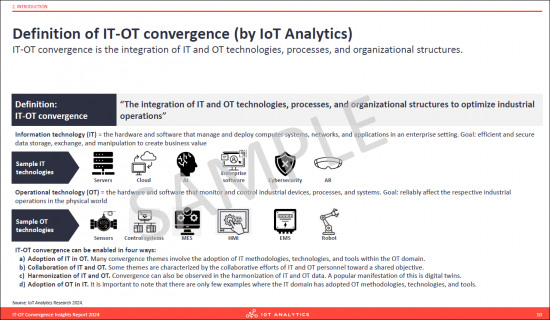PUBLISHER: IoT Analytics GmbH | PRODUCT CODE: 1583178

PUBLISHER: IoT Analytics GmbH | PRODUCT CODE: 1583178
IT-OT Convergence Insights Report 2024
The "IT-OT Convergence Insights Report 2024" is part of IoT Analytics' ongoing coverage of Industrial IoT. The information presented in this report is based on the results of secondary research and qualitative research, i.e., interviews with multiple stakeholders from the IT and OT domain between December 2023 and September 2024. The document includes the definition of IT-OT convergence, drivers and challenges of IT-OT convergence, 27 unique convergence themes grouped into seven categories, and more than 70 corresponding examples of IT-OT convergence implementation.
INFOGRAPHICS


The main purpose of this document is to help our readers understand the IT-OT convergence phenomenon by appreciating the various ways in which IT and OT are converging, which are explained throughout the document with real-world examples.
27 key themes that drive IT-OT convergence
IT-OT convergence integrates IT and OT to enhance industrial operations. IT-OT convergence involves combining IT systems that manage data with OT systems that control physical processes. The need for real-time data and flexible infrastructure drive the convergence. Companies are adopting convergence solutions to access real-time data and overcome legacy OT limitations. Key benefits include better visibility, security, and adaptability in operations.
INFOGRAPHICS

The following key themes are driving IT-OT Convergence:
- 1. Agile, DevOps, Modularity and as-a-service models brings flexibility to OT software development and deployment.
- 2. Popular IT technologies are getting adopted in OT. Examples include High-level programming languages, Low-code tools, use of AI, APIs such as REST and GraphQL, software marketplaces, containerization and AR (Augmented Reality)
- 3. Several IT cybersecurity principles like Zero Trust, TPM (Trusted Platform Module), Network segmentation are coming to OT. IEC-62443 integrates IT cybersecurity principles.
- 4. IT and OT software applications running in the cloud and at the edge. IT applications at the OT edge enhance real-time processing. OT applications in the cloud offer scalability.
- 5. IT-OT data integration enabled by Protocol converters, Message brokers, Advanced wireless technologies, Industrial DataOps, Digital twins, IoT data integration platforms, and Device management solutions is central in IT-OT convergence.
- 6. Collaborative IT-OT teams, Cross-domain training and Interdisciplinary hiring lead to IT-OT COnvergence.
- 7. OT hardware is becoming more IT-like by advancements like Hardware/software decoupling, OT hardware virtualization and Advanced computing at the edge.
INFOGRAPHICS


Questions answered:
- What is IT-OT convergence?
- What are the drivers and challenges of IT-OT convergence?
- What is the overall addressable IT-OT convergence market?
- What are the key IT-OT convergence categories and themes?
- What are key examples of IT technologies adopted in OT settings?
- Which new organizational and technological themes are emerging to foster IT-OT collaboration?
- How is OT hardware evolving to cope with future IT-OT convergence?
- What are some key examples of vendors offering solutions for IT-OT convergence?
- What are some key examples of industrial companies and manufacturers adopting IT-OT convergence topics?
Companies mentioned:
A selection of companies mentioned in the report.
|
|
Table of Tables
1. Executive summary
2. Introduction
- 2.1. IT-OT convergence definition
- 2.2. Evolution of IT-OT convergence
- 2.3. Differences between IT and OT
- 2.4. Market opportunity of IT-OT convergence
- 2.5. IT-OT convergence: Overview
- 2.6. Drivers of IT-OT convergence
- 2.7. Challenges of IT-OT convergence
3. Convergence category 1: IT principles
- 3.1. Agile
- 3.2. DevOps
- 3.3. Modularity
- 3.4. As-a-service
4. Convergence category 2: IT technologies
- 4.1. High-level programming
- 4.2. Low-code
- 4.3. Artificial intelligence
- 4.4. Modern APIs
- 4.5. Software marketplaces
- 4.6. Containerization
- 4.7. Augmented reality
5. Convergence category 3: IT cybersecurity
- 5.1. IT cybersecurity practices
6. Convergence category 4: IT-OT applications
- 6.1. IT applications at the OT edge
- 6.2. OT applications in the cloud
7. Convergence category 5: IT-OT data
- 7.1. Protocol converters
- 7.2. Message brokers
- 7.3. Advanced wireless connectivity
- 7.4. Industrial DataOps
- 7.5. Digital twins
- 7.6. IoT data integration platforms
- 7.7. Device management
8. Convergence category 6: IT-OT skills
- 8.1. Collaborative IT-OT teams
- 8.2. Cross-domain training
- 8.3. Interdisciplinary hiring
9. Convergence category 7: OT hardware
- 9.1. Hardware-software decoupling
- 9.2. Virtualization
- 9.3. Advanced computing
10. Methodology
11. About IoT Analytics




